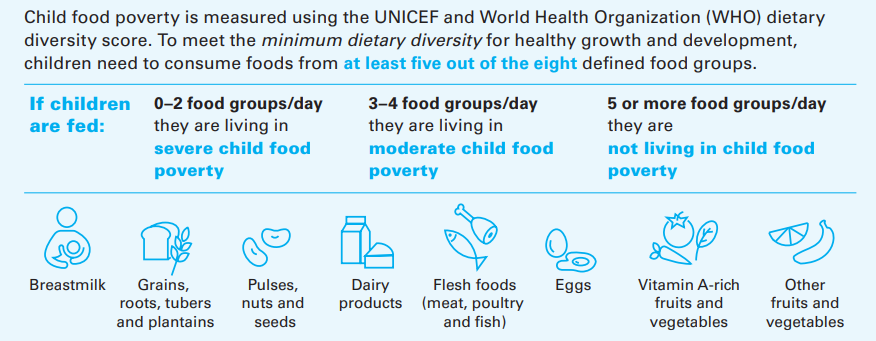India’s Children Lack Dietary Diversity | 06 Nov 2024
For Prelims: World Health Organization, National Family Health Survey (NFHS-5), Integrated Child Development Services (ICDS), Public Distribution Systems, Infant and Young Child Feeding (IYCF) practices, UNICEF.
For Mains: Challenges and Recommendations in Achieving Dietary Diversity.
Why in News?
According to a recent study, 77% of children in India aged 6-23 months do not meet the dietary diversity standards recommended by the World Health Organisation (WHO), with the country’s central region having the highest rates of minimum dietary diversity failure.
Minimum Dietary Diversity (MDD)
- It refers to a recommended standard set by the WHO for children aged 6-23 months.
- It suggests that within 24 hours, children should consume foods and beverages from at least five of the eight defined food groups.
- Breast milk, grains, legumes, dairy products, flesh foods, eggs, and fruits and vegetables.
- A child's diet is considered to have failed MDD if they consume food from fewer than five of these food groups.
- MDD is part of the Infant and Young Child Feeding (IYCF) practices, which are assessed by a suite of indicators developed by the WHO and UNICEF. The MDD is also a component of the Minimum Acceptable Diet (MAD) indicator.
What are the Key Highlights of the Study?
- Historical Comparison: Utilising data from the National Family Health Survey (NFHS-5) conducted between 2019 and 2021, researchers noted a decline in the overall failure rate of MDD from 87.4% in NFHS-3 (2005-06).
- Despite some improvement, over 75% of children still lack diverse diets, highlighting an alarmingly high prevalence and ongoing challenges in ensuring adequate nutrition.
- State Variance: The study found that states like Uttar Pradesh, Rajasthan, Gujarat, Maharashtra, and Madhya Pradesh exhibited over 80% inadequacy in dietary diversity, reflecting significant regional disparities.
- In contrast, Sikkim and Meghalaya reported levels below 50%, highlighting successful local nutritional strategies that could be models for other regions.
- Status of WHO Dietary Diversity Standards: According to the study, about 35% of the global child deaths and 11% of the total disease burden are due to inadequate nutrition.
- While in India, 1 in 3 children are underweight and stunted, and 1 in 5 children are wasted.
- Dietary Trends by Food Groups: Certain dietary trends have shown marked improvement.
- Despite these gains, breast milk and dairy consumption declined, with breastmilk dropping from 87% in NFHS-3 to 85% in NFHS-5 and dairy from 54% to 52%.
- Undernutrition and Anaemia: The study emphasises that undernutrition and anaemia are still major health issues. It found that children from rural areas, with illiterate mothers, or mothers with limited access to media and healthcare (such as Anganwadi services) are more likely to have diets lacking diversity.
- Related Recommendations:
- This study underscores the necessity for robust government initiatives to improve child nutrition, such as enhancing the Integrated Child Development Services (ICDS) and Public Distribution Systems.
- The findings suggest that targeted interventions could further reduce the prevalence of dietary deficiencies.
Types of Undernutrition
- Wasting: Low weight-for-height is known as wasting. It occurs when a person has not had enough food to eat and/or they have had an infectious disease.
- Stunting: Low height-for-age is known as stunting. It often occurs due to insufficient calorie intake, leading to a low weight for a given height.
- Underweight: Children with low weight-for-age are known as underweight. A child who is underweight may be stunted, wasted, or both.
What are the Major Challenges in Achieving Dietary Diversity in India?
- Economic and Regional Disparities: High poverty rates and regional inequalities limit access to diverse foods, particularly in central and western states.
- Limited Nutrition Education: A lack of awareness among caregivers, especially in rural areas, reduces understanding of balanced diets, contributing to undernutrition.
- Public Distribution Gaps: The PDS often focuses on staple grains, offering limited variety and missing nutrient-rich foods like legumes, fruits, and vegetables.
- Healthcare Access and Counseling Deficit: Poor access to healthcare facilities and nutrition counseling lacks essential information, affecting children’s dietary choices.
- Social and Cultural Factors: In some communities, dietary choices are influenced by cultural norms that may deprioritize certain food groups, limiting children’s exposure to varied diets.
Related Government Initiatives
Way Forward
- Strengthening Public Distribution System (PDS): Include nutrient-rich foods such as pulses, legumes, and fortified cereals in PDS to improve access to a variety of food groups.
- Expanding Nutrition Education Programs: Implement community-based nutrition education initiatives, especially for mothers, on the importance of diverse diets and meal planning.
- Enhancing ICDS and Anganwadi Services: Intensify efforts to monitor child nutrition, provide counselling, and supply balanced food options through ICDS centers.
- Leveraging Technology and Social Media: Use digital platforms for nutrition awareness campaigns targeting rural and urban areas, focusing on easily accessible dietary diversity practices.
- Promoting Local and Affordable Food Options: Encourage local cultivation and consumption of nutrient-dense foods like pulses, fruits, and vegetables to make dietary diversity more affordable and sustainable.
|
Drishti Mains Question: Discuss the significance of dietary diversity in child development and evaluate government measures to address nutritional challenges in India. |
UPSC Civil Services Examination, Previous Year Question (PYQ)
Prelims:
Q. With reference to National Rural Health Mission, which of the following are the jobs of ‘ASHA’, a trained community health worker? (2012)
- Accompanying women to the health facility for antenatal care checkup
- Using pregnancy test kits for early detection of pregnancy
- Providing information on nutrition and immunization.
- Conducting the delivery of baby
Select the correct answer using the codes given below:
(a) 1, 2 and 3 only
(b) 2 and 4 only
(c) 1 and 3 only
(d) 1, 2, 3 and 4
Ans: (a)
Mains:
Q. There is a growing divergence in the relationship between poverty and hunger in India. The shrinking of social expenditure by the government is forcing the poor to spend more on non-food essential items squeezing their food-budget. Elucidate. (2019)

